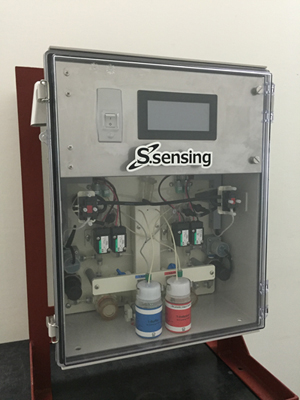2017
December 1,2017
Development of S.sensing®WS, a New TRO Meter for the Ballast Water Treatment Market
Space-saving water quality measurement device equipped with ultra-compact high performance sensors realizes optimal control of ballast water treatment
Kurita Water Industries Ltd. (Head Office: Nakano-ku, Tokyo; President: Michiya Kadota) is pleased to announce that it has developed S.sensing®WS , a new TRO meter for the ballast water treatment market, and has been granted model change approval for KURITA BWMS, Kurita’s ballast water treatment system equipped with the product, from the Ministry of Land, Infrastructure, Transport and Tourism, in September this year. S.sensing®WS delivers space savings together with optimal control of ballast water treatment, and can also be fitted in ballast water treatment systems manufactured by other companies. Kurita will seek to expand applications of KURITA BWMS in the future and will also start sales of S.sensing®WS as a standalone device through collaboration with the MOL Group.
In ballast water treatment, a TRO ( Total Residual Oxidants) meter is a measurement device that measures the concentration of various kinds of active substances(*1) used to kill harmful organisms in ballast water. TRO is an indicator of the concentration of chemicals (chlorine compounds, etc.) injected into the ballast tanks or ballast water lines of ships, and since accurate measurement of the concentration of these chemicals significantly affects the efficacy of chemicals and treatment costs, Kurita has been working on the development of new TRO meters based on analysis technologies, which it has accumulated through water treatment.
The new product, S.sensing®WS, is fitted with newly developed ultra compact high performance sensors and can measure TRO concentration quickly and with high accuracy through photoradiation of the measured liquid, which has been colored with a DPD method(*2), and photoreception using these sensors. Also, on a ship, various types of devices are packed into limited space, therefore devices need to be compact. Kurita delivered space savings by establishing a new product specification that houses two types of sensor with different measurement ranges (high-concentration range and low-concentration range) in one measurement device and measures the two ranges simultaneously. In terms of operation control, the new product reduces running costs by setting reagent volumes that are easy to manage during ship-board operation and is also equipped with a function that automatically cleans the reagent line in case of prolonged shutdown of the system.
S.sensing®WS also remotely monitors equipment status via the Internet, enabling TRO concentration measurements, alarm history and other record data necessary for operation control of the ballast water treatment system to be checked at any time, anywhere (See (*3) for more details about S.sensing®).
Kurita plans to conduct proposal activities to expand orders for KURITA BWMS with S.sensing®WS. Kurita will also promote sales expansion of S.sensing®WS as a standalone device through collaboration with MOL Techno-Trade, Ltd. (Head Office: Chuo-ku, Tokyo; President: Hiroshi Hatta) and seek wider application in ballast water treatment systems manufactured by other companies.
In the ship market, Kurita has built up a track record of delivering water treatment chemicals and systems ever since starting to sell boiler chemicals in 1949 as its founding business. In the future, Kurita will enhance its product lineup with KURITA BWMS and S.sensing®WS at the core and strengthen services using IoT and will pursue initiatives for the realization of total solutions in the ship market generally.
- *1:Active substances:Refers generally to substances with sterilizing properties such as chlorine compounds and ozone.
- *2:DPD method:A method used to measure TRO concentration, which involves measuring the concentration of total residual oxidants including residual chlorine through the addition of reagent to water containing TRO and detection of the extent of coloring.
- *3:S.sensing®:Refers generally to water treatment services using sensing technology in Kurita’s water treatment chemicals business. These services enable optimal water treatment on a real-time basis by installing the sensing equipment in the customer’s existing factory, and bundling the "measurement," "analysis," "control," and "monitoring" functions. 。
[Referencial press release]https://www.kurita.co.jp/english/aboutus/press160927.html
<New TRO meter S.sensing®WS>
- Dimensions:W400mm × D216mm × H465mm
-
- Feature:
- Working from the perspective of ship crew, we adopted a unique design
that makes the front cover transparent so that information such as processing state,
operating trouble and reagent levels can be checked visually.


